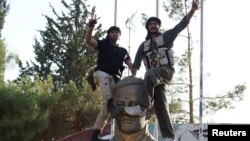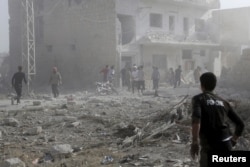Rebel fighters captured a major base from the Syrian army in the south of the country on Tuesday, rebels and a monitoring group said, a setback for President Bashar al-Assad reflecting the mounting pressure on him after recent losses elsewhere.
Syrian officials could not immediately be reached for comment. The Syrian Observatory for Human Rights, a British-based monitoring group, said a nearby town and a village had fallen to the rebels in addition to the base, Liwa 52.
"In under six hours today, the Free Syrian Army's Southern Front successfully completed an operation to liberate Brigade 52," said Issam al-Rayyes, spokesman for the Southern Front alliance of rebel groups. Liwa 52, or the 52nd Brigade, is one of the biggest Syrian army bases in the area.
"This is the last regime-held area to fall in eastern Daraa, and acted as a reinforcement base to support regime air bases in Sweida," Rayyes said in a statement, adding that at least 67 government troops, including seven officers, were killed.
The southern region near the border with Jordan and Israel is one of the areas where insurgents have inflicted significant defeats on Assad in the last three months, notably by capturing the Nasib border crossing with Jordan on April 1.
Less than 100 kilometers (60 miles) south of Damascus, the area is one of the last major footholds of rebel groups that are not dominated by hard-line jihadists such as Islamic State and the Nusra Front, al-Qaida's Syrian arm, although Nusra also has a presence there.
Syrian report
Earlier, Syrian state TV reported that the army had repelled an attempt by "a terrorist group" to infiltrate a military position in the area. It said a number of the attackers had been killed and wounded, including a rebel commander.
The air force was carrying out raids in the area, it added.
The Southern Front has been coordinating operations against Assad from a joint command center in Jordan. It includes groups that have received some support from foreign states that want to see Assad gone, including Gulf Arab governments.
Washington, which has been leading an air campaign against Islamic State since last year, says its strategy depends on encouraging the success of groups that oppose both Assad's government and the jihadists.
Saber Safar, commander of the First Army rebel group that said it led the attack, told Reuters by Skype that government forces had completed a "mass flight" after starting to withdraw in recent days.
The rebels fired more than 100 missiles at the base during the attack, the opposition-affiliated Orient News TV station said.
Since late March, an alliance of insurgents including the Nusra Front has seized nearly all of the northwestern province of Idlib on the Turkish border. Islamic State has also seized the city of Palmyra from government control.
In both cases, the Syrian military and militias battling alongside it have appeared to withdraw rather than fight. Analysts say the decisions to retreat point to strain in the army after more than four years of combat.
Chance for a deal?
The pressure has prompted Western policymakers to suggest a window of opportunity for a political deal may be opening in Syria after a war that has killed well over 200,000 people and left 8 million homeless.
But the defeats have also triggered renewed statements of support for Assad from Iran, whose backing has been crucial to his survival.
While Assad has suffered setbacks in the northwest, southwest and east, he has tightened his grip over the border zone with Lebanon, thanks to a joint operation over the last month with the Iranian-backed Lebanese group, Hezbollah.
The operation underway in the Qalamoun border region has cleared insurgents from hundreds of square kilometers between Syria and Lebanon.
Hezbollah fighters came under fire from Islamic State militants for the first time in the Qalamoun campaign on Tuesday, Lebanese sources and Hezbollah said.
Hezbollah said scores of Islamic State fighters were killed, including several commanders, and that it had the bodies of at least 14 fighters. Lebanese sources said at least four Hezbollah fighters were killed in the attack.
There was no comment from Islamic State on the fighting.
Meanwhile, U.S. and allied forces conducted 14 airstrikes in Iraq and nine in Syria against Islamic State militants during a 24-hour period ending on Tuesday morning, the U.S. military said.
In Syria, six of the airstrikes were concentrated around Kobani near the Turkish border and three near the Islamic State stronghold of Raqqa, the statement said.
Observatory's toll
The Observatory also said Tuesday that it had documented the deaths of 230,000 people since the Syrian conflict began in March 2011.
The organization said the dead included 69,494 civilians, among them 11,493 children. The conflict has also claimed the lives of 49,106 troops, 32,533 pro-government fighters and 38,592 rebels, it told The Associated Press.
The others killed include army defectors, Islamic State militants, foreign fighters and members of Lebanon's Hezbollah.
Observatory director Rami Abdurrahman said the real death toll could be above 300,000, since there are tens of thousands of people who are missing or were buried without being counted.
The U.N. said last year that the war has killed at least 220,000 people. That figure has not been updated.





